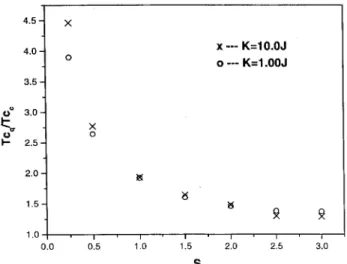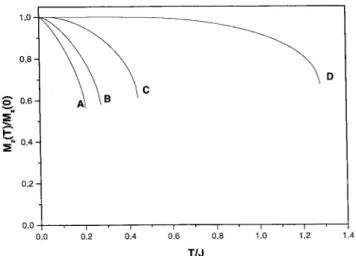Low Temperature Stati Behavior of the
Two-Dimensional quantum Easy-Axis Heisenberg Model
S. A.Leonel
and A. S. T. Pires +
Departamento deFsia,ICEUniversidade Federalde JuizdeFora,
Juiz deFora,CEP36036-330, MG,Brazil
+
Departamento deFsia,ICEx,UniversidadeFederaldeMinasGerais
BeloHorizonte,CP702,CEP30123-970,MG, Brazil
Reeived2January,2000
Weusetheself-onsistentharmoniapproximation(SCHA)tostudystatipropertiesof the
two-dimensionalquantumHeisenbergmodelwitheasy-axisanisotropy. We alulatetheritial
tem-peratureasafuntionofthespinvalue,andomparewithlassialresults. Speially,weompare
howtheratioofritialtemperaturesvariesasafuntionofthespinSinthequantumandlassial
ases,foraxedanisotropyparameter. Weseethat,forvaluesofspinnear5/2,thelassialresult
approximatestothequantumresultsandthelassialalulationisjustied. Wehavealsostudied
thebehavior of themagnetization for verysmallanisotropies. We haveshownthatour
magneti-zationurvesdonotpresentaplateau inthe limitofverysmallanisotropies,as preditedby the
real-spaerenormalization-groupalulations.
I Introdution
Low-dimensionalmagnets havebeenextensively
inves-tigatedby many theoristsand experimentalists in the
last three deades. Morereently, the interest onthe
properties of two-dimensional (2D) Heisenberg
mag-nets has been greatly revived sine the disovery of
high-T
superondutivity: it is now well known[1℄
that the undoped, insulating La
2 CuO
4
has a
quasi-two-dimensionalantiferromagnetibehavior. However,
mostquasi-two-dimensionalmagnetirealmaterials
ex-hibitsomekindof anisotropy: theanisotropi
proper-tiesoftenarise notsomuh from ananisotropyin the
interationmehanism(whihanbewhollyisotropi)
but fromothersoures,suhasthepreseneofa
rys-tal eld that ouples the spins to a ertain diretion
in therystal. Then, at leastfrom a theoretialpoint
ofview,alargeamountofmagnetimaterialsts
(un-der ertainirunstanes liketemperaturerange) into
one ofthetwogroups: easy-planeoreasy-axismodels.
Easy-plane 2D magnets have deserved a lot of
atten-tion due to their possibility of showing the
topologi-alKosterlitz-Thoulessphasetransition.[2℄Theinterest
devotedtoeasy-axismagnetisystemshasbeen
onsid-erablysmaller.
In a reent paper[3℄, we have studied the stati
and dynamial behavior of the two-dimensional
las-sial easy-axis Heisenberg model. In the refered
pa-per we have used a lassial treatment and our
ana-lytial results, for both stati properties and dynami
ulationdataombiningluster-MonteCarloalgorithms
andSpinDynamis. Theomparisonallowedusto
on-ludethatbelowthetransitiontemperature,wherethe
SCHA is valid, spin wavesare responsible for all the
relevantfeatures observedin thenumerial simulation
data: topologialexitationsdidnotseemtoontribute
appreiably.
It must be emphasized that, although we shall be
onerned only with magneti systems in this paper,
many of the magneti Hamiltonians also allow for an
interpretation otherthenamagnetione. Most
physi-al problemsonerningmutuallyinteratingelements
that form aspatial array an bemapped into a
mag-netiHamiltonianbydesribingitwithinapseudospin
formalism. Theadvantadgeofstudyingageneral
phys-ialprobleminitsmagnetiformislearlythatin
mag-netismseveralexperimentaltehniquesareavailableto
studythefundamental propertiesofasystem.[4℄
Theanalysisofthe generalIsing-Heisenbergmodel
is of interest beause, from the experimental point of
view,thepresene ofsomedegreeofanisotropyin the
interationisto beexpetedin nearlyallases.
Here we onsider the two dimensional Heisenberg
ferromagnetwitheasy-axisexhangeanisotropy
H = J X
n;a S
n S
n+a K
X
n;a S
z
n S
z
n+a
(1)
where the summations run over all distint pairs of
from the isotropi Heisenberg model to an Ising like
modelinwhihthespinstendtobeonnedalongthe
z diretion.
In this paper we onsider the ontribution of spin
waves,usingaself-onsistent harmoniapproximation
theory (SCHA). Asiswellknown,theSCHA is a
rea-sonable approximationto alulatethetransition
tem-perature and low-temperature properties of a system
but it isof limitedvalue in estimatingritial
proper-ties. Therefore, in our work, we did not attempt to
do any alulation for ritial exponents and related
aspetsof aphasetransition.
Weuse aquantum treatment andompare our
re-sult with the lassial one in order to see when the
lassialalulationisjustied.
Wegiveourquantumresultsfortheritial
temper-ature as afuntion of the anisotropy parameterK =J,
for a xed value of the spin, and for small and large
anisotropies. We ndthat, for large anisotropies, the
ritial temperature are given as T
2:00K, to be
ompared with the 2D single-omponent Onsager
re-sult fortheIsingmodelvalue,T
2:27K.
In the limit of small anisotropies, we nd that
ontrary to the real spae renormalization-group
alulation[5℄, the magnetization urves does not
ex-hibit a plateau as a funtion of temperature, wih
is in agreement with the alulation of Reinehr and
Figueiredo[6℄.
II Self-Consistent Harmoni
Approximation
SineitsoriginalderivationbyBloh,[7℄theself
onsis-tentharmoniapproximationhasbeenfoundtoaount
forthelowtemperaturedependeneof various
proper-ties of several magneti insulators, whih seem to be
fairlywell-desribedbytheHeisenbergmodel.[8,9,10℄
Its usefulnessstemsmainly from thewayittakesinto
aount a substantial part of the interations among
spinwaves,beingharaterizedbysimple
temperature-dependentrenormalizationfatorsfortheunperturbed
spinwaveenergy.
Westartbywritingthespinomponentsusingthe
Dyson-Maleevrepresentationofspinoperators
S x n = 1 2 h p 2S(a y n +a n ) i 1 p 8S a y n a n a n S y n = 1 2i h p 2S(a y n a n ) i 1 p 8S a y n a n a n (2) S z n
= S a
y n a n where a y n and a n
are theBose spin operators on site
(1)isgivenby
H 0 = X q ! q a y q a q (3) wherea y q anda q
aretheFouriertransformsofa y
n and
a
n
respetively,and
!
q
=4JS[1 (q)℄+4KS (4)
with(q)= 1
2 [osq
x +osq
y
℄. Thespinwave
approx-imation will be reasonable when ha y
n a
n
i S, so it
ought to be fairly good for anisotropiessatisfying the
relationT 4KS 2
.
Now we simplify the general model by
redu-ing Hamiltonian (1) to an eetive harmoni
prob-lem with the eet of the anharmoniity embodied in
temperature-dependentrenormalizedparameters. This
means that the ouplings of the model are replaed
by quadrati interations whose strength is then
op-timized. Details of this method may be found in the
literature[7,9℄andherewegiveonlyanoutlineofthose
stepspertinenttoourpresentalulation.
WeassumeaseetiveHamiltoniantheappropriate
formforanoninteratinggasofBoseexitations
~ H 0 = X q E q a y q a q : (5)
Thespinwaveenergyisobtainedbyavariational
pro-edurebasedontheinequalityforthefreeenergyF
F ~ F 0 +hH ~ H 0 i 0 ; (6)
wherethebraketsindiatethethermalaverage.Traes
should be takenonly overthephysial states,that is,
stateswithnomorethan2Sspindeviationsonasingle
site. The minimization of (5) with respet to E
q
de-terminesthespin waveenergies. Weobtain, following
Rastellietal,[9℄
E
q
(T) = 4JS(1 (q)) h
1 ~
(T)+(T~ ) i
+ 4KS h
1 ~
(T) (q)~(T) i
(7)
where
~
(T)= 1 NS X q n q (8) ~ (T)= 1 NS X q (q)n q (9) Heren q
istheBosedistribuition
n q =(e Eq(T)=T 1) 1 (10)
Eqs. (7), (8), and (9) are oupled equations whih
solution below T
and no real solution aboveT
: this
isthetypialbehaviorforselfonsistentharmoni
ap-proximations andallows for easydetermination of T
.
Thelowerbranh (forT <T
)hasanunphysial
tem-peraturedependeneand maybedisardedasa
spuri-ousmathematialsolutionthatisphysiallyunstable.
III Stati Results
InFig. 1theratio betweenthequantum and lassial
alulationfortheritial temperature, fortwovalues
of anisotropy K =J = 1:0 and K =J = 10:0, are given
asafuntion of thespin. Wesee that whenthevalue
of the spin inreases, the ratio between quantum and
lassial resultsapproximate to one. This behavioris
expetedfor thedomain ofvalidityofthelassial
ap-proximation.
Figure1.Ratiobetweenquantumritialtemperatureand
lassialritialtemperatureasafuntionofspinS,fortwo
valueofanisotropies, K=10:0J andK=1:0J.
Figure 2. Redued ritial temperature T=J as a
fun-tionofanisotropyparameterK =J,forsmallanisotropiesand
S=1=2.
In Fig. 2 weshowthe ritial temperature
behav-iorasafuntion oftheanisotropyparameterK =J,for
small anisotropies and spin S=1/2. We see when K
tendstozero,thehamiltonian(1)tendstothe
Heisen-bergisotropimodelandtheritialtemperaturetends
to zero,asexpeted.
InFig. 3wegivetheritialtemperatureasa
fun-tion ofthe anisotropyparameterK =J, for K =J >1:0
and a onstant value of spin S = 1: Notie that, as
K inreases, the dependene of T
on K =J beomes
linear. For K =J 1, we reover a ontinuous spin
Ising Hamiltonian: Eq. (1) an be approximated as
H J(1+K =J)S z
n S
z
n+a =
~
KS z
n S
z
n+a
. Fig. 3shows
that, for K =J >1:0, theresults followa straightline
with slope 2:0. For these anisotropies, T
2:0K
wih is near to the 2D single-omponent Ising model
value,T
2:27K.
Figure3. ReduedritialtemperatureT
=J asafuntion
oftheanisotropyparameterKforS=1:0.
Theredued spontaneous magnetization along the
z-axisisgivenby
M
z (T)
M
z (0)
=1 ~
(T) : (11)
InFig. 4we presentresults obtainedfrom eq.(11)
for small anisotropies, that is, K =J = 0:001, K =J =
0:01, K =J =0:07, K =J = 1:0, and thespin S =1=2:
Themagnetizationalulatedusingthisequationdrops
disontinouslytozeroatatemperaturethatwetakeas
Figure 4. Reduedmagnetizationasafuntionof
temper-ature for small anisotropies and S=1/2. Curve A
orre-spond to K =0:001J, urveB to K =0:01J, urve Cto
K=0:07J andurveDtoK=1:0J.
In two reent papers [5, 6℄ the authors have
al-ulated the magnetization as a funtion of
temper-ature for this model with spin value S = 1=2: In
the rst [5℄, the author have applied the real spae
renormalization-groupandhaveshowthat,inthelimit
ofsmall anisotropies,themagnetizationurvesexhibit
a plateau as a funtion of temperature. In the
se-ond [6℄, where the authors have applid the
formal-ism of Green's funtions, they have shown that, in
limit of small anisotropies, the magnetization urves
didnotexhibitaplateauasafuntionoftemperature.
In our alulation,the magnetization urves forsmall
anisotropies doesnotexib aplateau, asFig. 4shows.
Ouralulationsistheninagreementwiththe
alula-tionofReinehrandFigueredo[6℄.
IV Conlusions
Wehaveappliedaself-onsistentharmoni
approxima-tiontothequantumeasy-axismodel,obtainingthe
rit-ial temperature and magnetization urves. We have
demonstrated that the quantum and lassial results
fortheritialtemperaturesareloseforvaluesofthe
spin greater then one. Thus, we see that the
lassi-al approximation, for valuesof spin grater than one,
is reasonable and thequantum eets are appreiable
only forsmall valuesof the spin. Inthe limitof large
anisotropies, that is K =J >> 1,we get an Ising like
diretion. We nd, in this limit, T
2:00K whih
isnear T
2:27K for the2D single-omponent Ising
model.
Wehavealsoshownthat themagnetization urves
did not exhibit a plateau for small values of the
anisotropy. This behavior is in agreement with that
observedintheGreen'sfuntionalulationsandis
dif-ferentfromthatobservedinthereal-spae
renormaliza-tionalulationswhereaplateau appears.
Aknowledgements
WewishtothankProf. FlavioI.Takakurafor
valu-abledisussionaboutthiswork.
Theauthors gratefully aknowledge thesupport of
Funda~ao de Amparo aPesquisa do Estado de Minas
Gerais(FAPEMIG), Funda~ao Coordena~aode
Aper-feioamentodePessoaldeNvelSuperior(CAPES)and
ConselhoNaionaldeDesenvolvimentoCientoeT
e-nologio(CNPq).
Referenes
[1℄ Low Dimensional Condutors and Superondutors,
editedbyD.JeromeandL.G.Caron,NATOAdvaned
StudiesInstitute,SeriesB,Vol.155(Plenum,NewYork,
1987).
[2℄ J.M Kosterlitz and D.J. Thouless, J. Phys. C6, 1181
(1973);V.L.Berezinskii, Zh.Eksp.Teor.Fiz.61,1144
(1971)(Sov.Phys.-JETP).
[3℄ M.E.Gouv^ea,G.M. Wysin, S.A.Leonel, A.S.T. Pires,
T.KamppeterandF.G.Mertens,Phys.Rev.B59,6229
(1999).
[4℄ L.J.deJongh,ed.MagnetiPropertiesofLayered
Tran-sitionMetalCompounds(Kluwer,Dordreht,1989).
[5℄ A.Chame,J.Phys.Condens.Matter3,9115(1991).
[6℄ E.E.ReinehrandW.Figueiredo,Phys.Rev.B52,310
(1995).
[7℄ M.Bloh,J.Appl.Phys.34,1151 (1963).
[8℄ P.D.Loly,J.Phys.C4,1365(1971).
[9℄ E. Rastelli, A. Tassi, L. Reatto, J. Phys. C 7, 1735
(1974).
[10℄ D.A.Poling, R.H. Parmenter, Phys.RevB 16, 3240

